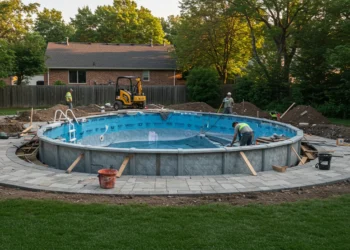As the world continues to grapple with climate change, homeowners are increasingly turning to sustainable home improvement ideas that reduce their carbon footprint. Sustainable home improvement involves making changes to your home in a way that minimizes its impact on the environment while also providing energy savings and cost benefits.
Here are five sustainable home upgrade ideas that will help you reduce your carbon footprint:
Install Solar Panels
Clean, sustainable energy can be produced by solar panels and used to power your home. They work by harnessing the energy from the sun and converting it into electricity. This reduces your reliance on fossil fuels and lowers your carbon footprint. Additionally, solar panels can also save you money on your electricity bill over time.
If you’re considering installing solar panels, you’ll need to determine the best location for them on your property and calculate how many panels you’ll need to meet your energy needs. You’ll also need to decide between a grid-tied system or a battery storage system, which can help you store excess energy for later use.
Use Sustainable Building Materials for home improvement
When renovating or building a new home, consider using sustainable building materials such as reclaimed wood, bamboo, and recycled steel. These materials are eco-friendly, renewable, and often have a lower environmental impact than traditional building materials.
Reclaimed wood, for example, is salvaged from old buildings or structures and can be repurposed into flooring, furniture, and decor. Bamboo is a fast-growing plant that can be harvested sustainably and used for flooring, countertops, and cabinets. Recycled steel is made from scrap metal and can be used for roofing, siding, and framing.
Also learn about 8 Things to Know Before Adding Bamboo Screening to Your Home.
Upgrade to Energy-Efficient Appliances
Upgrading to energy-efficient appliances can help you save money on your energy bill while also reducing your carbon footprint. Energy Star-certified appliances, such as refrigerators, dishwashers, and washing machines, are designed to use less energy than their traditional counterparts.
When shopping for new appliances, look for the Energy Star label, which indicates that the appliance meets specific energy efficiency standards. Additionally, consider purchasing appliances that have a high energy rating, such as those with an A+++ rating, which are the most energy-efficient.
Install Energy-Efficient Lighting
Switching to energy-efficient lighting is an easy way to reduce your carbon impact and save money on your energy bill. LED bulbs, for example, use up to 80% less energy than traditional incandescent bulbs and can last up to 25 times longer.
When shopping for energy-efficient lighting, consider the lumens, or the amount of light produced, rather than the wattage. LED bulbs typically have a lower wattage but produce the same amount of light as traditional bulbs. Additionally, consider purchasing smart lighting systems that allow you to control your lighting from your smartphone and set schedules to conserve energy.
Improve Your Home’s Insulation
Proper insulation is essential for reducing energy waste and lowering your carbon footprint.
To improve your home’s insulation, consider adding insulation to your attic, walls, and floors. Additionally, ensure that your windows and doors are properly sealed to prevent drafts and energy loss.
Blinds can be an effective way to help insulate your home and improve its energy efficiency. They work by creating an additional barrier between the inside and outside of your windows, which can help reduce heat loss during the winter months and keep your home cooler during the summer.
This added insulation can help reduce your home’s energy consumption, which can lead to lower energy bills and a reduced carbon impact. By investing in high-quality blinds like Sunscreen Roller Blinds or Blockout Roller Blinds and using them strategically throughout your home, you can help to create a more comfortable and eco-friendly living environment.
In conclusion, adopting sustainable home improvement ideas is an excellent way to reduce your carbon footprint and contribute to a more environmentally friendly world. These five ideas – upgrading to energy-efficient appliances, switching to LED light bulbs, using eco-friendly building materials, installing a smart thermostat, and utilizing renewable energy sources – are simple yet effective ways to make your home more sustainable.
By making these changes, you can not only save money on your energy bills but also reduce your impact on the planet. Keep in mind that every action counts for a better future.








